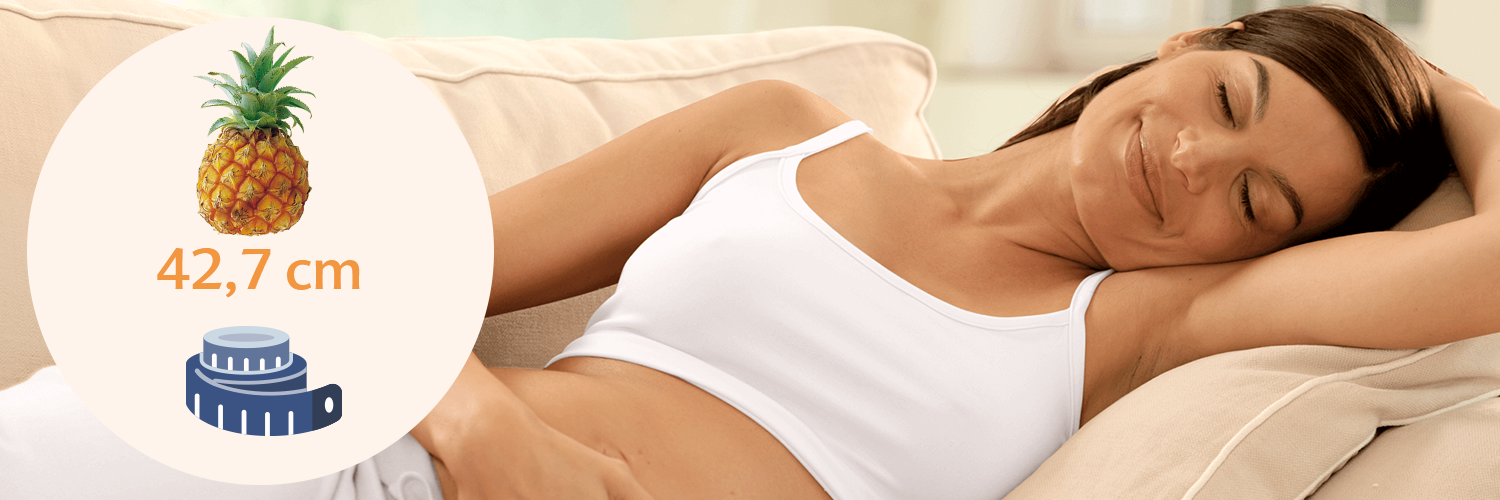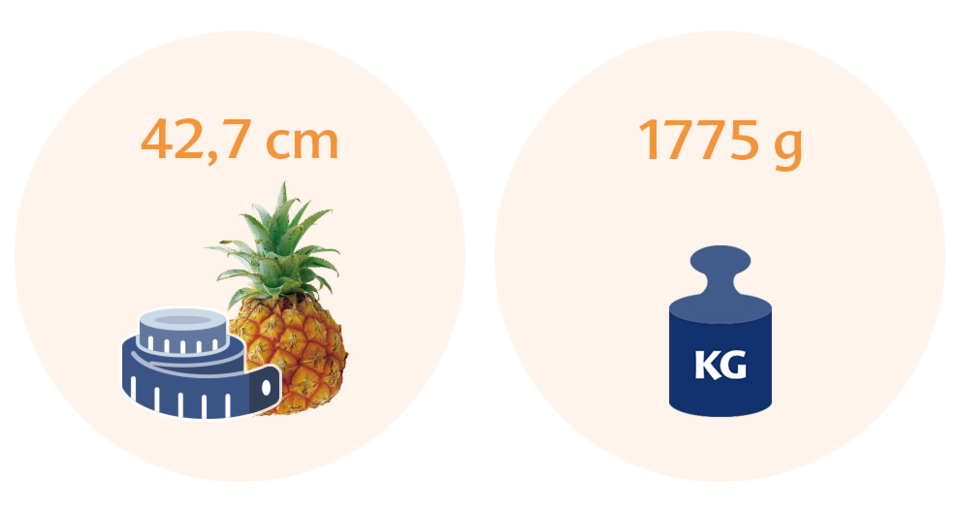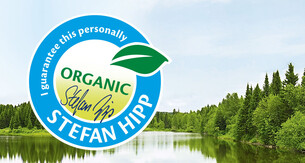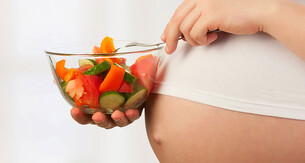By week 32, your baby is 42.7 cm in size, so about as big as a pineapple (including its green leaves). Their weight is steadily increasing and has now reached 1775 grams. By the time they’re born, they’ll have grown longer and put on a lot more weight in the form of baby fat.
Pregnancy weeks:
Week 32 of pregnancy: Your bump is still getting bigger

Size of your baby in week 32
Your baby’s development
What it’s like for the mum-to-be in week 32
Top tips
Questions you may want to ask your doctor or midwife
In week 32, you’re in the last week of the eighth month of your pregnancy – you’re approaching the final straight, and it won’t be long before you can hold your baby in your arms. However, your soon-to-be bundle of joy has a bit more work to do before that can happen.
Size of your baby in week 32

Your baby’s development
If you’re lucky enough to be expecting twins, it’ll be harder and harder for your doctor to assess their development in an ultrasound in week 32. They’ll be broadly at the same stage of development, though one is likely to be longer and heavier than the other.
Around 1 in 250 pregnancies result in twins, so they aren’t that uncommon, and women who have had IVF treatment are more likely to have twins. In week 32, your baby’s body is nearly fully formed, and their organs are complete and just need to fine-tune a few aspects of how they work. This includes their lungs, where the alveoli are working more effectively thanks to the protective surfactant. This protein stops them adhering to each other, and it’ll be needed in larger quantities in the near future.
Since your baby doesn’t have much space in the womb anymore, they’ll curl up ever more tightly in the foetal position. Kids continue to adopt this position, curled up like a foetus on their side, when they sleep – in fact, so do some adults.
Your baby’s legs are drawn up to their body, and they’ll sometimes suck on their big toe in order to keep training their sucking reflex. Their arms are crossed over their tummy, and between them is the umbilical cord, which they’ll be determinedly pulling on every now and again. You can also tell that they’re practising breathing because their hiccups get more intense.
By this stage, your baby is almost fully developed and already looks like a small newborn. However, they still need to build up their subcutaneous fat, which will make them a bit chubbier, help them lose the remaining few wrinkles from their skin and serve as vital reserves for their first few days outside the womb until you start producing mature breast milk.
They’re also continuing to train and develop their senses, which will allow them to perceive and respond to the world around them once they’re born. One skill they learn is to regulate their body temperature: after the birth, they can to a certain (and increasing) extent maintain it and keep themselves warm.
What it’s like for the mum-to-be in week 32
Your pregnancy will become more and more onerous, depending on the size of your bump and your fitness. It’s now a good idea to stop doing things you find difficult, and your partner, friends and family need to step up and help you out by doing things that need to be done, e.g. assembling the baby furniture.
Maternity and paternity leave are also an issue now. You should have told your employer by now when you want to start your maternity and paternity leave and sorted out your application for maternity pay. You may also be entitled to parental allowance or child benefit, so you should start looking into that as well and applying for it if you’re eligible.
Common signs and symptoms
Noticing preliminary contractions
Although you’re often short of breath, this symptom actually eases a little when the preliminary contractions start. Around three to four weeks before you give birth, you’ll feel your belly harden or tighten with considerable intensity, which can cause stomach ache and make you feel a bit nauseous.
These contractions are also known as false labour, and your bump moves down a little as a result. It means your lungs are no longer being squeezed by the uterus, and you’ll find breathing easier again. On the other hand, you’ll need to go to the toilet even more often as the pressure on your bladder increases, and your stomach will now only be able to process even smaller portions.
Your baby’s movements become more intense
You won’t just feel your baby moving at certain points of your belly, but all over it. They now have a larger body and are trying to move around in your womb to get into the right position for birth.
The symptoms from previous weeks continue
Your legs and feet may still be painful and swollen. This is more likely if you’re pregnant during the hot summer months – it’s less common and less intense in winter.
The issue of having to go to the toilet a lot remains, and the signs of minor stress incontinence won’t have gone away just yet either.
Midwife’s advice
“Don’t worry, if minor incontinence issues persist after birth. Your body needs a certain amount of time to recover. Should you have any questions about your condition, your midwife or gynaecologist will be there to answer them.”
Dorothee Kutz, midwife
Many women feel better immediately after giving birth, and this may make you even more impatient. You’ll be thinking: hurry up, baby!
Changing sexuality
Try to spend quality time together as a couple. You can still be sensual and sexual even with your big baby bump by getting creative or snuggling up close to your partner – this will do you both and your baby the world of good as the body contact and touching produce oxytocin, the bonding hormone. This sense of an emotional connection is what makes our relationships with the people we love truly special.
Top tips
- If you have swollen or painful feet, buy tights with a non-elastic band so that they don’t cut into your legs. Also take every opportunity you get to put your feet up (literally!).
- When it comes to buying your baby’s first clothes, long or short babygros are recommended depending on the time of year. These are useful because your baby won’t enjoy having their clothes changed in the early days.
- Look for baby jumpers with a press-stud placket on the shoulder, as this will make putting them on a bit easier (babies often refuse to have anything put on over their head).
- Make sure you’ve got your application for maternity/paternity leave, maternity pay, parental allowance/child benefit, etc., sorted out, as these can take time to be processed.
- Muslin burp cloths will come in very handy time and time again after the birth, whether as something to rest your baby’s head on or as a covering cloth.
Questions you may want to ask your doctor or midwife
Instructions and financial arrangements with doctors and midwives
If you’re unsure about anything and are taken to hospital, your doctor will need to provide instructions so that you can be treated and the clinic can charge for the treatment. Ask your doctor when they can give this authorisation, which you should keep with you at all times.
If you hire a freelance midwife to look after you during and after the birth, you’ll need to make financial arrangements with her so that she can be paid. It’s a good idea to sort this all out early on so that you can relax as much as possible before the birth.
Ask your midwife about how often she can visit you and your baby at your home to check up on how you’re doing, which will involve monitoring your vaginal discharge after giving birth, seeing how your body is getting back to normal and weighing your baby. Find out if she’s happy to be on call – i.e. to come to you whenever you might need her, even if it’s late at night.
Information about the author:
Juliane Jacke-Gerlitz is a registered nurse. She has been working in the field of mother and breastfeeding counselling for more than ten years. Currently she is working as a medical writer and psychological consultant. Juliane Jacke-Gerlitz has been married for 22 years, is a mother of eight children and lives with her family in Halle.




